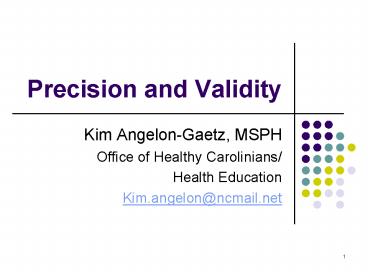Precision and Validity - PowerPoint PPT Presentation
1 / 23
Title:
Precision and Validity
Description:
In a recent outbreak, peanut butter was found to be associated with salmonellosis. ... odds of getting ill after eating peanut butter were 2.53 (1.26, 5.31) times the ... – PowerPoint PPT presentation
Number of Views:119
Avg rating:3.0/5.0
Title: Precision and Validity
1
Precision and Validity
- Kim Angelon-Gaetz, MSPH
- Office of Healthy Carolinians/
- Health Education
- Kim.angelon_at_ncmail.net
2
Precision vs. Validity
- Precision how much variability
- Validity how close to the true value
Precise but not valid
Valid but imprecise
3
2 Types of Validity
- Internal Validity
- What is the quality of the information that you
gathered about the sample? - External Validity
- Do your sample data pertain to the general
population? - Can you generalize your findings?
4
Speaking of Validity
- You can never know what the true association
between exposure and disease is, so you cant
measure validity. - Plan your survey to minimize bias.
- Report any leftover problems that might have
biased your survey.
5
The Balancing Act
- Reducing
- Increases
- Random error
- By increasing sample size
- By making your study more efficient
- Bias/ Systematic error
- By improving measurement, selection and
participation
- Precision
- Validity
6
Measuring Statistical Significance
7
Statistical vs. Clinical Significance
- Statistical significance the finding is
important based on a statistical test - How likely is it that the observed effect
happened by chance? - Clinical significance the finding is important
based on its clinical or practical implications
8
Statistical significance cont.
- Usually we test whether the p-value is below some
threshold, called alpha (a) - Ex If a 0.05
- P-value lt 0.05 statistical
significance - Alpha is
- A fixed value that we decide on BEFORE looking
at our data! - How much type I error we think is acceptable
9
Type 1 vs. Type 2 Error
- Type 1 Error Saying that a factor has an
association with the outcome when it really
doesnt - Type 2 Error Saying that a factor doesnt have
an association with the outcome when it really
does
10
Hypothesis Testing
- Using data to test a hypothesis about what is
associated with an outcome - Null hypothesis no association between exposure
and outcome - 1.0 for ratios or 0 for absolute measures
- The exposure is Innocent until proven guilty
- This is what we are testing!
- Alternative hypothesis
- Opposite of the null hypothesis
- Any/ Positive/ Negative Association
11
P-value
- The probability of finding an association as
strong or stronger than the observed association,
if the null hypothesis is true. - Compared to a to test our hypothesis
- Usually a0.05, meaning that a valid test should
(incorrectly) reject a true null hypothesis, no
more than 5 of the time.
12
Interpreting the P-value
- A low p-value (lt 0.05) means that the effect that
you found is statistically significant - BUT
- never interpret your findings based
- on the p-value alone!
13
Confidence Intervals (CI)
- Tell you something about both the precision of an
estimate and strength of association. - 1-a confidence level (usually 95)
- If you could repeat your study over and over
again using a correct model, valid test, and no
bias, the confidence intervals should contain the
true value 95 of the time.
14
Precision and Confidence Intervals
- Narrow confidence intervals precise!
- Confidence limit ratio (CLR) upper limit/ lower
limit - 1 is narrow
- Ex Odds Ratio 1.7 Confidence interval (0.9,
3.2) - CLR 3.2/ 0.9 3.56
- Interpretation
- This confidence interval is pretty narrow so it
is fairly precise! - It includes the null (1.0) so we fail to reject
the null hypothesis. - The association between exposure and outcome is
not statistically significant.
15
95 Confidence Interval
Point Estimate
0 0.9 1.0 1.7
3.2 5
Null
Upper Limit (UL)
Lower Limit (LL)
16
How are p-values and confidence intervals related?
- A rule of thumb
- When a confidence interval includes the null
value (1 or 0), the p-value will be a - When a confidence interval does not include the
null, the p-value will be lt a
17
Example Hypothesis Test
- In a recent outbreak, peanut butter was found to
be associated with salmonellosis. - Odds ratio and 95 confidence interval
- 2.53 (1.26, 5.31), p-value 0.007
- Interpret The odds of getting ill after eating
peanut butter were 2.53 (1.26, 5.31) times the
odds of getting ill without eating peanut butter.
- CI did not include the null and was fairly
precise (CLR5.31/1.26 4.2) - Result is statistically significant
18
Example 2 Large Sample Size
- Remember that the p-value doesnt tell you how
large the observed effect was. - If you have a really large sample size, you might
get a very small p-value even though the effect
is not very large - Risk Ratio1.80 (1.322.46) p-valuelt0.0001
- CLR 2.46/1.321.86
- The measurement is precise.
- The association is statistically significant but
not very large.
19
Information from p-values and confidence intervals
20
15 Variance Rule
- SCHS guideline for comparing health indicators
Pay attention to 15 difference - Compare your county to
- Peer or neighboring counties
- State
- Itself! (In years before)
- Look at improvement and problems
21
What DONT Statistical Measures Tell Us?
- Clinical relevance
- Validity
- Biologic plausibility
- Costs
- Benefits
- Feasibility
22
Making Informed Public Health Goals
23
References
- Rothman, KJ. (2002) Epidemiology An
Introduction. Oxford University Press. - Rothman, KJ and S Greenland. (1998) Modern
Epidemiology. 2nd Edition. Lippincott- Raven
Publishers.































